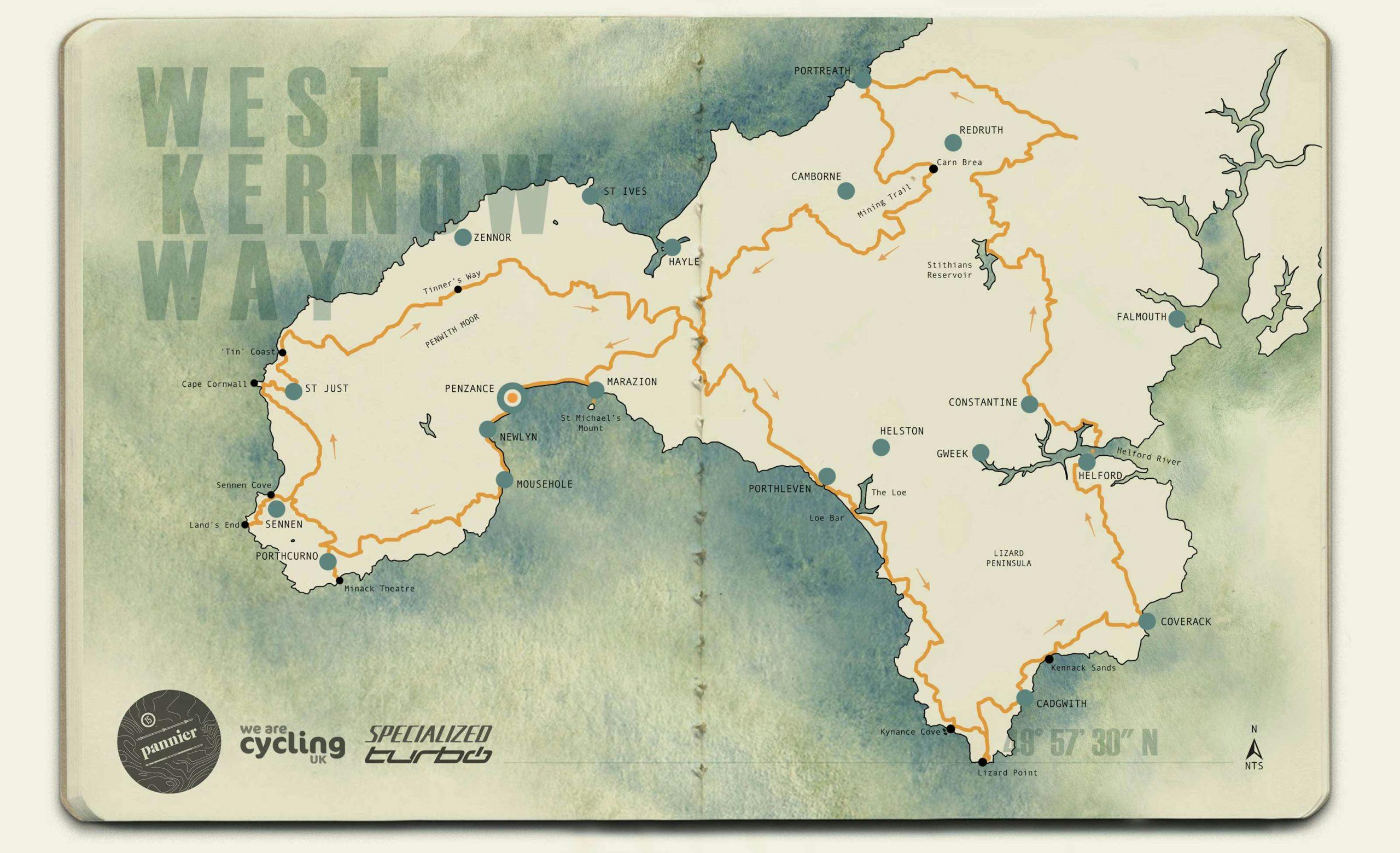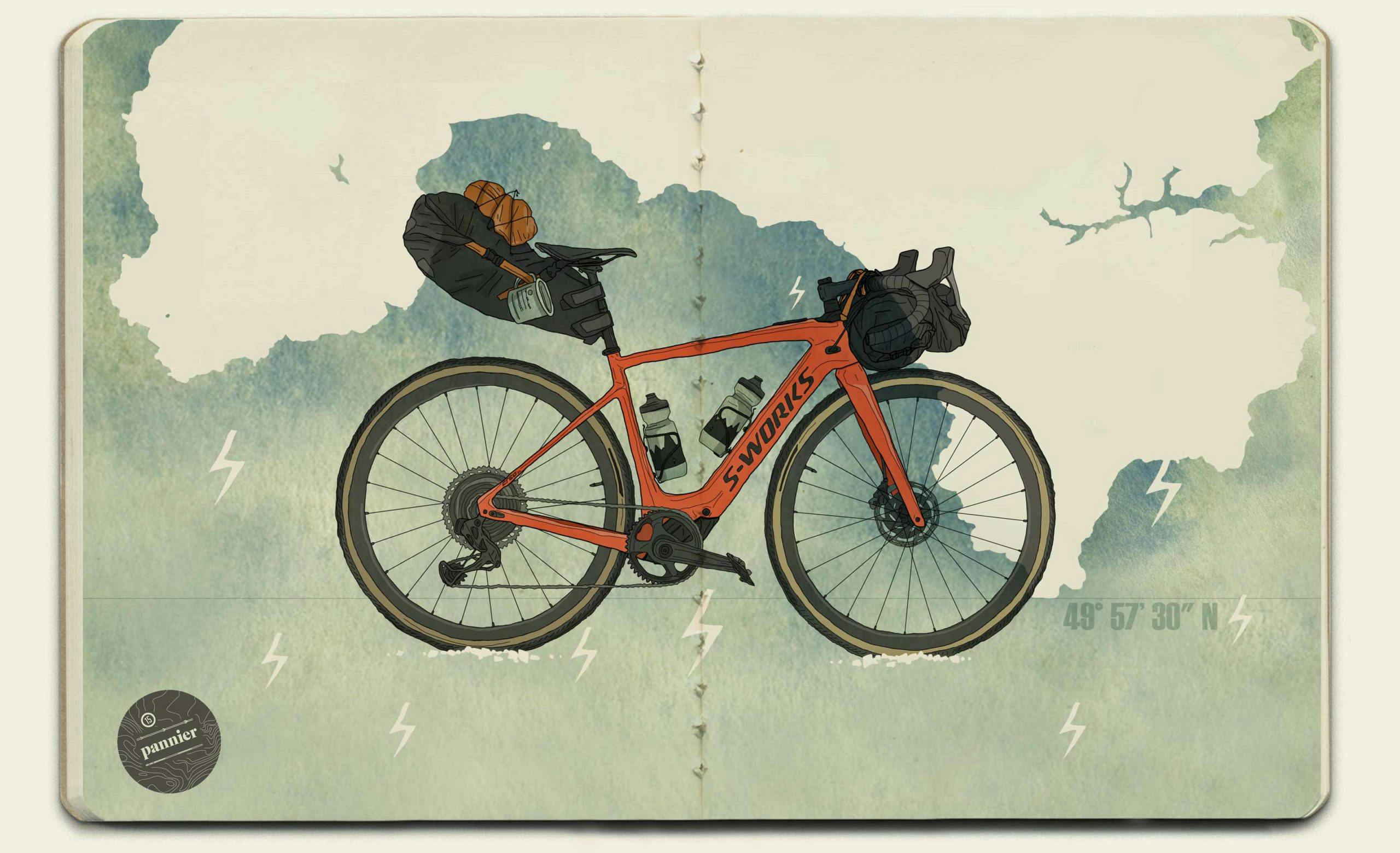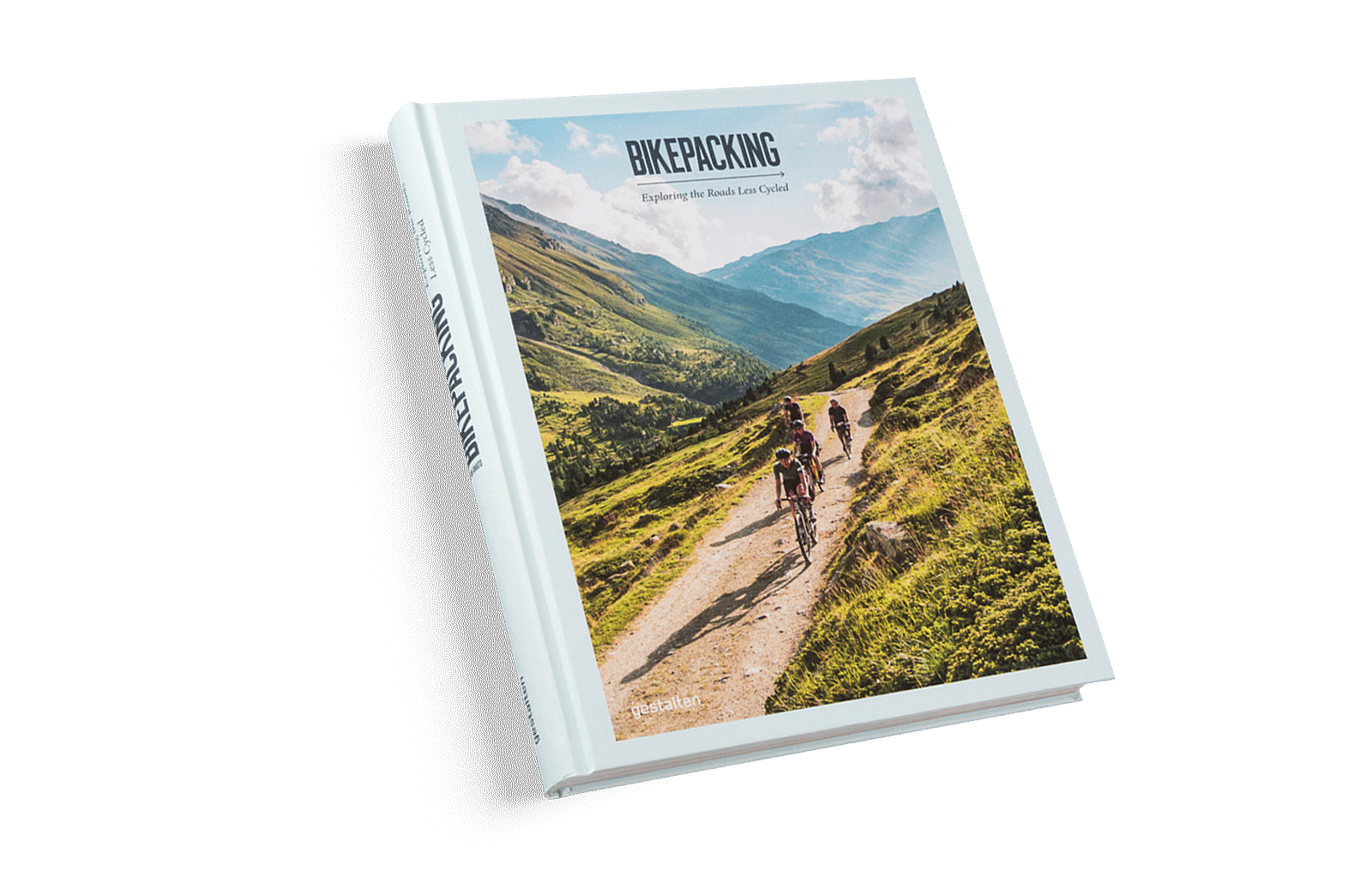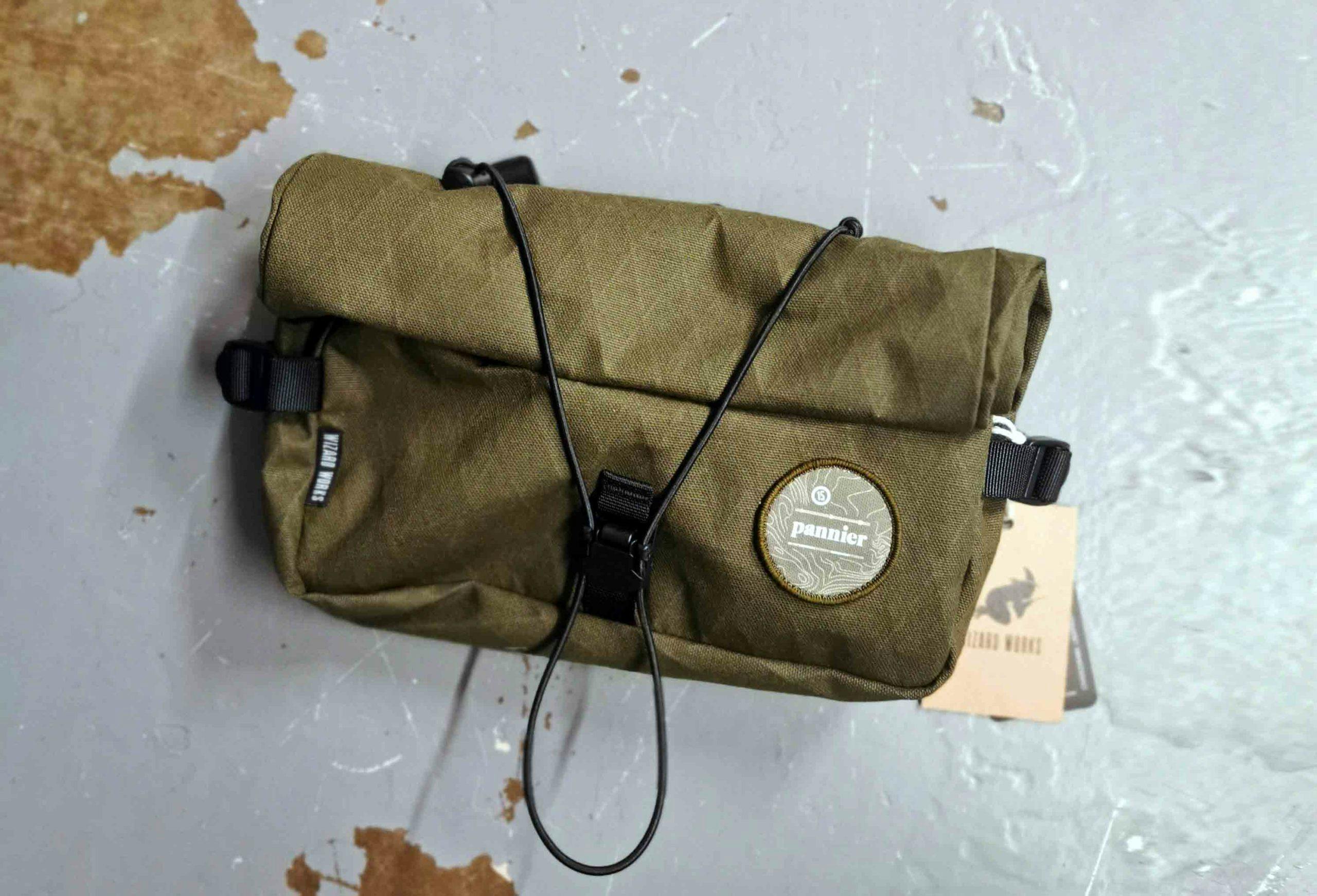
West Kernow Way / West Kernow Way – Route Guide
Specialized – ‘Creo’ E-Gravel Bikes
KERNOW [n]
Cornwall, in Cornish
A cappella song rang amongst the ruins of the King Edward mining buildings near Troon as the seven of us sheltered, and sliced another Saffron Cake. The humbling harmonies of the 50-strong Extinction Rebellion climate choir sure brightened a mizzly afternoon in this post-industrial mining moorscape. Both of us were nearing the end of our journeys: for them – the last of their 135KM hike from Plymouth to St Ives, raising awareness of climate at the G7 Meet in Carbis Bay; for us – the last hours of our 240KM bikepack.
Aside from the G7 drone-copters hovering above St Ives and the bustle of popular coastal towns, riding the West Kernow Way you’ll barely notice how busy Cornwall becomes, let alone being amidst a global event – the real beauty of off-road bikepacking routes. For three days, we were immersed in the largely unseen parts of this wild-western tip of the UK – off-the-beaten-track on Cornwall’s lost ways across beautiful beaches and into covert coves, over historic moors and along overgrown farm-boundary paths where, despite never being far away, we lost sight, scent, and sound of the sea…


Cornwall needs no introduction as a top destination and, sure enough, riding Cycling UK’s new multi-day off-road cycling route (funded by the European Regional Development Fund’s ‘Experience’ project) differed from pretty much all of my previous bikepack trips in that the West Kernow Way almost feels like an actual holiday. Penzance, Land’s End, Sennen Cove, Lizard Point, St. Michaels Mount and the Minack Theatre are all places you might have heard of or visited already – but journeying across the Penwith and Lizard Peninsulas in this figure-of-eight off-road loop sure opens up a few more: Helford Estuary, Cape Cornwall, The Tinner’s Way, and Kennack Sands. Yes, the Cornish coves, bays and river valleys make for a lot of climbing on the bike and her Lost Ways make for challenging terrain, but all the other sides to Cornwall: the coastline; history; location at the far-edge of our island; rolling farmland and moorlands; well stocked towns and villages; world class eateries; swimming and surfing; fishing and ferry hops; and, dare I say it, weather make for a super few days on the bike. Active travel at its finest.
The one-kilometre stretch through Mousehole at the very start of the route sure sets the tone for the rest of the trip; enough to get to know Cornwall early doors and regret the huge portion of Fraser’s Fish & Chips and local Rattler Cider the night prior on the Penzance Promenade. Corner into the calm coastal village, and then bang – a short, steep climb to knock the drying socks off your seatpack. Countless lively hedgerow lane kilometres follow, taking you to honeypot sites mentioned above like the somewhat vacuous Lands End, and sweeping Sennen Cove. I mean, you could spend the whole day at Sennen, but we had a lunch date with our foraging friend – Caroline (Fat Hen) – at Cot Valley’s rugged bay just off the West Kernow Way, between the bustling village of St Just and Cape Cornwall…






Swell crashed against the giant-pebble beach below as we pleasantly tucked into our foraged lunch around a stone picnic plinth – a basking break in the sunshine after arguably the techiest riding section of the West Kernow Way, along chunky and stepped sections of the South-West-Coast path. Caroline had been busy prepping that morning, and on the menu to fuel our next kilometres along the Tin Coast and over the Penwith Moors was:
– Seaweed & miso soup with wild foraged seaweeds: kelp, dulse, alaria, nori & sea lettuce. According to Caroline, around 600 types of seaweed cling to the rocks on the Cornish coast. She uses about 10, including the 5-or-so in our delicious starter.
– Wild vegan sushi made with siracha pickled vegetables and wild black mustard leaves, wild foraged furikake (seaweed & sesame seasoning), served with wild flowers (black mustard, tree mallow & marigold)
– Nettle & lemon cupcakes with elderflower mascarpone icing, decorated with dried rose petals



LOST WAYS [n]
– historic rights of way
– paths, tracks and trails that are officially (often mistakably) recorded as footpaths and at risk of being lost as rights of way for bikes and horses; for public access in general
Now then, Lost Ways. An intriguing term for the tracks and trails we, as bikepackers, spend time seeking out. However, it is less about off-road, overgrown brambly bridleways and more about administration and advocacy for lots of the UK’s legitimate historic rights of way network that are at risk of being lost. Sophie Gordon, one of our bikepacking squad and Campaigns Officer for Cycling UK says: “there are thousands of historical anomalies like this in the rights of way network across England, where routes were recorded incorrectly when councils were compiling their official maps in the 1950s.”
And, sure enough, looking over the OS Maps planning the logistics for this West Kernow Way bikepack it is clear to see sections of the route are footpaths, or at the least not marked as bridleways. These are the Lost Ways – routes that have been used for millenia, but have been lost to recent mapping processes. As part of Cycling UK’s advocacy and accessibility work, they are looking to rediscover and establish all these Lost Ways, and apparently we have until 2026 to take action. Sophie (and Cycling UK) insist that we start using these Lost Ways now – “the key thing is that the public’s right to ride on them still exists. It hasn’t just disappeared because they’ve been marked incorrectly on a map. These ancient routes which were used by horses and carts could form crucial links in our fragmented rights of way network, where currently only 22% is open for cycling.”
There are plenty of Lost Ways included on the West Kernow Way, and one of the most standout is the Tinners Way – a 30KM ancient track from St Ives to Cape Cornwall with a history dating back to the Bronze Age – used most recently as an integral highway in the 1700-1800s when mining along the Kernow Coast boomed; hence the name. This off-road section high on the Penwith Moors is also known as the ‘Old St Ives Road’ and, despite its long history as a local, pilgrim and trade route, maps don’t show proper access rights – “there’s no longer a continuous right of access for horses and carts, which would have used this track for millennia. Instead, parts of the route are marked as public footpaths, while other sections aren’t recorded as public rights of way at all” Sophie points out as we hike-a-bike-bushwhack through gorse and brambles towards our overnight at Penderleath, tucked amongst the rolling farmlands above St Ives. Experiencing these Lost Ways on bikes is a real adventure – a mix of chunky gravel, loose peat and moorland hike-a-bike – evidence that if we don’t tread this path by foot or tyre (gravel-specific of course) they will be lost back to nature/landowners for good.









The centre of the figure-of-eight West Kernow Way route – below the most prominent hill of the trip, Godolphin Hill (162m!) – signals the shift from the Penwith to the Lizard Peninsula and highlights inner Cornwall’s quieter parts – “everyone just goes to the food and drink” fretted Russ at our Penderleath campsite. He wasn’t wrong. For pretty much the whole of the eastern loop, it feels totally different around every corner – from beach hiking, to dry grassy singletrack, to Helford’s famed lush ancient woodlands, to gravel farm tracks through someone’s backyard. The perception of Cornwall is coast, but these inland rolling green farmland and grassy moorlands make for special riding and escape routes and are not token kilometres by any means.
Picturesque Porthleven makes for the perfect snack pause, with a whole array of food and drink outlets set around the bustling harbour. One of those places to sit and watch the world go by, before arguably the next standout section of the route starts once you round the sea wall and leave the town behind: a hike across stunning Loe Bar, and the Lizard coastline. We stopped for one of Ann’s pasties and a swift Kernow Cider in Lizard, before a dusky swim at Kennack Sands and a rush to Coverack on full e-bike boost mode to make last dinner and drink orders at the aptly named Paris Hotel. A great spot, nestled within the fishing village high above the sea, to watch the sunset and chow a big bowl of Cornish M̶o̶u̶l̶e̶s̶ Mussels. It turns out, the 1907 hotel is actually named after the SS Paris ship that ran aground at Coverack in 1899.







Electric bikes are here to stay, and undoubtedly the future for urban/utility travel, but do they have a place within bikepacking and leisure cycling?
After over a decade of riding acoustic bikes, I’ve been ‘ohm’ming and harring about a bikepacking trip on electric bikes for a while, having seen the number of e-mountain bikes around me in the Peak District. Like you, I had so many questions: how far can you go? How do you charge them? What happens if the battery runs out? How much faff are they? Does the weather or extra weight of bikepacking kit totally skew the range? And, therefore, how remote or wild can you really go on an electric bike, and for how many days? So, this year was time to plug-in; to give a bikepacking trip on an e-bike a go and seek the positives and negatives. Two things worked out timing-wise: Specialized had recently released their Creo electric gravel bike which is the ideal mixed-terrain bikepacking bike, and we were off to Cornwall which should provide the ideal testing ground; nothing could really go that wrong there, could it?
The West Kernow Way would be our first e-bikepacking trip, and from the outset, let’s get three things straight:
– e-bikes are fun to ride
– e-bikes are a great leveller for group riding, especially on multi-day bikepacks
– e-bikes don’t mean an easy ride

For most people, looking at our bikes from 20 metres away – even 5-10 metres away – you’d have no idea they were electric-assisted. Aside from the modest ‘Turbo Connect Unit’ top tube LED panel, tiny non-driveside charging port, and the frames enlarged bottom bracket region, there is very little to give it away. On the move, and it is a different story. Riding amongst a group, and you start to hear the gentle whirrs mid-way up Cornwall’s notorious short, steep coastal climbs as folk engage one of the three assistance levels, depending on a) how tired they are or b) how much battery juice they have left. The best way of describing what it’s like when you switch the battery off on an incline is like getting a pinch puncture; an instant change.
Specialized’s idea with the Creo electric gravel bike is to “open up gravel and off-road, whilst normalising the use of e-bikes” and I have to agree – there is a time, place and crowd for this. Did the seven of us need e-bikes for the West Kernow Way? No. However, let’s be honest, an e-bike is a blessing in Cornwall given the jagged elevation profiles, they were fun to ride, and if they open up cycling and active travel to more people that otherwise wouldn’t bikepack, then all the better. E-bikes might open up a bikepacking trip to those that are less confident or experienced. I’ve seen this in action this last summer on our Pannier trips – whether people have slight injuries or anxiety about ‘keeping up’ with the rest of the group, but want to join friends on challenging bike trips. It’s only positive.
The Creo SL is the lightest e-bike in its class – a carbon frame with lightweight motor delivering up to 240W of power that, they claim, leaves no resistance when riding unassisted. I have to say, riding it loaded through Cornwall for 240KM, this seemed legitimate. When the battery ran out, I was riding a bike that is lighter than my steel hardtails anyway, with little-no resistance – it’s a winner, and makes for a less anxious time bikepacking knowing that it wouldn’t be a burden if the juice runs out.
The bike’s long wheelbase, comfy geometry and Future Shock (headset suspension) make for great gravel riding machines. However, they’re not really made for loading up with bikepacking bags! Fitting a standard seatpack renders the dropper post redundant, and a standard top tube bag covers the battery control (Turbo Connect Unit) panel, unfortunately, even if there are basic control buttons on the handlebars. OK, so, the elephant on the route. These are expensive bikes. The COMP that Vedanghi and I were riding – dropper post, Shimano GRX groupset to take on shifting and braking duties, DT wheelset, with 38mm Specialized Pathfinder tyres is £5,750. Then the EXPERT that Sophie, Sam and Katherine rode – same, but with Ultegra Di2 electronic shifting and a fancier Roval wheelset is £7,500. The S-WORKS pinnacle build that Rob and Jordan were riding – SRAM Red AXS eTap, SRAM XX1 Eagle rear derailleur, and a 10-50t cassette for an incredible gear range, plus S/Works-Easton carbon finishing kits is a whopping £11,500 to buy.


The all important bikepacking question – how far can you go assisted? And when did I run out of juice?
Specialized claim there is a range of 128KM (80-mile) on the internal battery and that is probably about right, if you don’t use it much. On a loaded bike and using the assist sparingly, only switching on when I actually needed it, I had 1 bar (of 10) at the end of day two in Coverack, where we knew we would be able to charge the bikes. So, I’d essentially done a two-day 140KM bikepacking trip on an e-bike, with a night of camping. At the end of day one, after 70KM a good amount of off-road riding using bursts of lowest (Eco) and mid (Sport) assist modes, I had used 5 bars (50% of the battery). If you were using the assist a lot more – whether time-wise in the lowest setting (Eco), or using the full-boost (Turbo) setting a lot more – that would likely need a charge every night or 70KM, easily. It’also worth bearing in mind that these bikes are top-end, so expect those ranges to differ a great deal for other brands and e-bike styles.
Given the weight of the charger (and space they take up in lightweight bikepacking bags) I carried one charger for the group in my backpack, and we worked on charging shifts until last orders at The Paris Hotel (it’s a steep run up to the YHA and back!) and early morning to ensure everyone had enough juice for the last day – 24-minutes/bike was enough for 2 bars each (20%ish charge) so you can do the math on how long a full charge takes, roughly.
As e-bikes become more popular, as they are doing for leisure touring and travelling, in addition to utility cycling, it’ll be interesting to see how accessible charging points become. At the moment, in the UK, anyway it is very much a case of rocking up places and plugging into standard sockets out the way in cafes, or back rooms in hotels; relying on the good will of the owners. But, it’s not quite the same as sneakily charging a phone – it’s a step up both cost and etiquette wise. Much like electric vehicles debate, for mass-participation e-bikepacking the range and availability/accessibility of charging points is key. And, like phone chargers, charger compatibility should shy away from being proprietary across brands to enable shared use amongst groups.










– Range. Test it properly. Bikepacking Terrain (off-road) and Bikepacking Luggage (weight) will affect things from manufacturer’s recommendations
– Pedalling efficiency when battery dead, or off?
– Lightness of bike when battery dead for riding?
– Lightness of bike if when needing to push or carry?
– Location of charging points. Plan your route around these, or just risk and see how you go? Might take the spontaneity out of a trip.
– Option to carry an extra battery, or range extender? They can be heavy, and expensive!
– Compatibility of chargers? If with others, can you share?
– Group dynamics if there are a mix of e-bikes and, let’s say, ‘acoustic’ bikes?
– Route knowledge. Knowing the route will help you manage and reserve juice for when you actually need it.
– Battery anxiety. It’s a thing, trust me. Much like water anxiety on remote expeditions.
– Jealousy is real, when you’re out of juice and can hear the gentle whirr of a motorised crank.


This Journal is not meant as a practical route guide, as such, rather a general overview of our trip and experience – you can find all the details in Cycling UK’s West Kernow Way Official Guide. It is the latest in a series of off-road bike packing routes that our National charity are curating; following the King Alfred’s Way and Great North Trail and it really is a route for nature, foodie, flora, wildlife, history, and coastal lovers. I’ve been to Cornwall on bikepacking trips twice in a couple of months now – recently riding Penzance to Padstow – and this route is definitely the ‘adventure’ option for Cornwall – avoiding roads and the busier routes wherever possible. As mentioned, the route also shows off a different largely undiscovered inland side to Cornwall, and does feel like a holiday. Which definitely cannot be said for a lot of bikepacking trips!
The beauty of a a figure of eight route is that you can join each of the two loops wherever you need or want to, or do each loop over two separate rides, using Penzance, Marazion or the surrounds as a base. The West Kernow Way is ‘designed’ to be ridden clockwise, starting in the heart of Penzance – on the seafront promenade – to the south-westerly point of the UK (Land’s End) and then anti-clockwise on the eastern loop via the most southerly point of the UK (Lizard Point), finishing at St Michaels Mount – Cornwall’s iconic tidal island. We rode the route over three full days, and would suggest that is a decent pace to get around; four is probably best if you’re keen to stop for sea swims, pause for pasties and generally take a bit more time without rushing. Leaving Penzance early morning on Day 1, we overnighted in:
– Penderleath – Camping (Penwith Peninsula)
– Coverack – Glamping (Lizard Peninsula)
– Penzance – B&B












Accommodation-wise, there are plenty of places to stay on or near the route whatever your bikepacking taste or the weather is doing – hotels, b&bs, campsites, hostels, bunkhouses – Cornwall is set up for tourism, in a big way.
Like all good UK bikepacking routes “the West Kernow Way uses a mixture of quiet lanes, cycle paths and bridleways that vary from smooth grass to loose rock or narrow singletrack sheep trails over moors.” There is also plenty of gravel too, and short sections of hike-a-bike so be prepared to carry and push your loaded bikepacking bike – the Tinners Way, Loe Bar, and the climb up from Kennack Sands are the most memorable of those.
Bike wise, “the West Kernow Way’s mix of testing gradients and varying surfaces make it perfect for gravel bikes or mountain bikes”. I’d agree, but I’d add ensuring low gearing options – it is Cornwall, off-road, after all. We completed the route on 700 x 38c tyres, and it was fine. As is always the case, there were some sections we needed to push/carry for and bigger tyres would’ve been comfier on a lot of the rideable off-road sections, but if you’re experienced off-road and prefer the nimbler-nature of gravel tyres on all the lane and tarmac sections, 42c or less is fine. One thing’s for sure, don’t go near it with an out-and-out road bike. Unless you like walking.
There is a growing movement for people to travel in the shoulder seasons, generally, and there is no more sensible place to avoid the peak summer season than Cornwall. Go for Spring or Autumn – the sea should be a touch warmer in early Autumn, anyway. Given the terrain and potential trail conditions, it is best to avoid deep winter. Although, as is not always the case with off-road bikepacking routes, if sections do become a bit tricky, there are plenty of detours available on the network of Cornish lanes to make your life easier.
The West Kernow Way isn’t signed at all, and uses a whole mix of varying National Trails so you’ll need navigation options – gps device, or old-school paper maps.
Phone and 4G coverage is pretty much there along the whole route – you’re never more than a few kilometres from a road or village anyway. One thing to check and confirm is opening times and the need for bookings in the more popular places. I am a huge advocate for spontaneous travel, of course, but as you’ll well know the fallout from the Pandemic has meant planning ahead is a good idea. One thing you cannot book over the phone or internet is the small Helford River Ferry – this can only be done by flipping the Jetty signal board over at the quaint village of Helford. Once the ferry-person sees it big and yellow, rather than standard red, they buzz their way over between all the anchored boats to pick you up.




To end the trip, we were lucky enough to be treated to both a cold muscle-rejuvenating dip and relaxed heated geothermal sesh at the 1935 Art Deco Seawater Lido – Jubilee Pool – built into the rock on the edge of Penzance harbour. They also have showers; a bikepacker’s dream, especially if jumping on the Sleeper train home. A fitting end to the trip, before the seven of us recounted our favourite bits of the West Kernow over a few local Polgoon Sparkling Apple Wines at the Jubilee Pool bar.
Time to plan a trip to Cornwall in 2022?
West Kernow Way Routesmiths
Cycling UK – Sophie Gordon, Kieran Foster, Guy Kesteven
Partners
Cycling UK
Specialized Turbo
Photos
Jordan Gibbons
Words & Illustration
Stef Amato
Tourers
Rob Penn
Vedanghi Kulkarni
Sam Jones
Katherine Moore
Sophie Gordon
Stef Amato
Jordan Gibbons
WESSEX WANDERINGS: BIKEPACKING KING ALFRED’S WAY
Five Ride Out Of Covid-19 Lockdown, onto King Alfred's Way - a new 350km bikepacking route around the ancient kingdom of Wessex; across vast downlands that somehow echo the comfort of a countryside in which man has always been at home...
by STEF AMATO & DAVE SEAR
RAINSPOTTING
Six of us alight the sleeper train at Corrour - the highest, remotest station on the West Highland Line - and 'go for a w̶a̶l̶k̶ ride' through the wintry, gloomy Grampian Mountains of Scotland. We track the old-established north-south drove roads and, in true drover style, explore the alluring moorland voids in between...
by STEFAN AMATO & DAVID SEAR
BIKEFISHING THE SECRET DALE
Bikefishing? Oh yes. We strap fishing rods, flies, and overnight kit to our gravel bikes for a bike-fishing journey along the River Nidd. Along the way, we meet up with Nidderdale AONB fly fisherman, Oscar, who takes us upstream fishing in the river and stillwater fishing at the local upland reservoir. Time to see what the bike fishing hype is all about...
by STEF AMATO & DUNCAN PHILPOTT
WESSEX WANDERINGS: BIKEPACKING KING ALFRED’S WAY
Five Ride Out Of Covid-19 Lockdown, onto King Alfred's Way - a new 350km bikepacking route around the ancient kingdom of Wessex; across vast downlands that somehow echo the comfort of a countryside in which man has always been at home...
by STEF AMATO & DAVE SEAR
RAINSPOTTING
Six of us alight the sleeper train at Corrour - the highest, remotest station on the West Highland Line - and 'go for a w̶a̶l̶k̶ ride' through the wintry, gloomy Grampian Mountains of Scotland. We track the old-established north-south drove roads and, in true drover style, explore the alluring moorland voids in between...
by STEFAN AMATO & DAVID SEAR
BIKEFISHING THE SECRET DALE
Bikefishing? Oh yes. We strap fishing rods, flies, and overnight kit to our gravel bikes for a bike-fishing journey along the River Nidd. Along the way, we meet up with Nidderdale AONB fly fisherman, Oscar, who takes us upstream fishing in the river and stillwater fishing at the local upland reservoir. Time to see what the bike fishing hype is all about...


